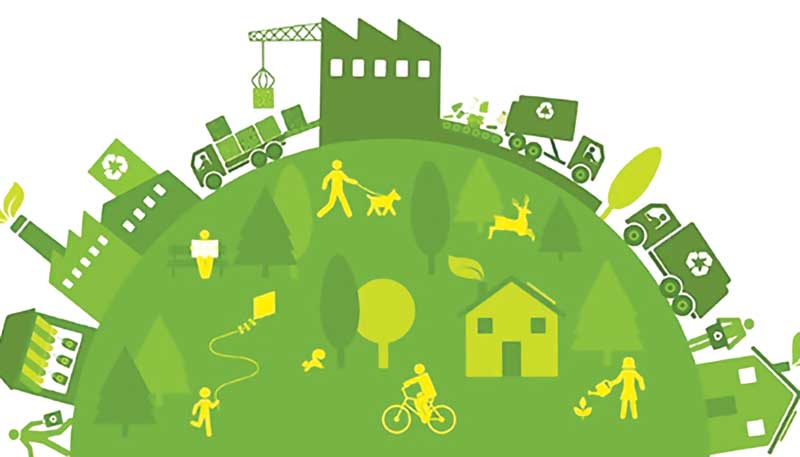Green In Regulation Meaning
Green regulation in building construction is a concept that is gaining increasing importance in today's world. With growing concerns about climate change and the need for sustainable development, regulations and standards are being put in place to ensure that the construction industry contributes to a greener and more environmentally friendly future. In this article, we will explore the meaning of green regulation and its significance in building construction.
1. What is Green Regulation?
Green regulation refers to the set of rules and guidelines that are aimed at promoting sustainable practices in building construction. These regulations cover various aspects such as energy efficiency, water conservation, waste management, and the use of environmentally friendly materials.

Image source: observerbd.com
Green regulation is designed to minimize the negative environmental impacts of construction activities and promote the adoption of greener and more sustainable practices. It encourages builders and developers to design and construct buildings that are energy-efficient, resource-efficient, and have minimal environmental footprint.
2. Benefits of Green Regulation
The implementation of green regulation in building construction offers several benefits:
- Environmental Sustainability: Green regulation helps in reducing greenhouse gas emissions, conserving natural resources, and protecting ecosystems. It ensures that buildings are designed and constructed in a way that minimizes their impact on the environment.
- Energy Efficiency: By incorporating energy-efficient measures, such as insulation, efficient lighting, and renewable energy systems, green regulation helps in reducing energy consumption and lowering utility bills.
- Improved Indoor Air Quality: Green buildings are designed to have better ventilation systems, use low-toxicity materials, and reduce indoor pollutant sources. This ensures a healthier and more comfortable living and working environment.
- Long-term Cost Savings: Although the initial costs of constructing green buildings may be higher, the long-term savings in energy and maintenance costs make them economically viable in the long run.
- Enhanced Market Value: Green buildings are in high demand as they offer numerous benefits. They tend to have higher market value, attract more tenants, and provide better rental returns.
3. Green Regulation in Practice
The implementation of green regulation in building construction involves the following key aspects:

Image source: YouTube
3.1 Energy Efficiency
Energy efficiency is a crucial component of green regulation. It involves the use of energy-efficient appliances, lighting systems, and HVAC (heating, ventilation, and air conditioning) systems. The design of the building should also prioritize natural lighting and ventilation to reduce the need for artificial lighting and mechanical cooling.
3.2 Water Conservation
Water conservation measures include the installation of low-flow fixtures, rainwater harvesting systems, and efficient irrigation systems. The goal is to reduce water consumption and promote the efficient use and management of water resources.
3.3 Waste Management
Green regulation emphasizes proper waste management practices during construction and the operational phase of a building. This includes recycling and reusing construction materials, minimizing waste generation, and ensuring proper disposal of hazardous materials.
3.4 Use of Environmentally Friendly Materials
Green regulation promotes the use of environmentally friendly and sustainable materials in building construction. This includes materials with low embodied energy, recycled content, and those that can be easily reused or recycled at the end of their life cycle.
FAQs
Here are some frequently asked questions about green regulation in building construction:
Q: How do green regulations impact the cost of construction?
A: Green buildings may have higher upfront costs compared to conventional buildings. However, the long-term energy savings and potential monetary incentives can offset these costs over time.
Q: Are there any certifications or standards for green buildings?
A: Yes, several certification programs, such as LEED (Leadership in Energy and Environmental Design), exist to evaluate and certify green buildings based on their sustainability performance.
Q: Do green buildings only apply to new construction?
A: No, green regulations also apply to retrofitting existing buildings. Renovation and retrofit projects can incorporate sustainable practices to improve the energy efficiency and sustainability of older buildings.
Q: How can I ensure compliance with green regulations?
A: To ensure compliance, it is essential to consult with architects, engineers, and contractors who are knowledgeable about green building practices. Additionally, keeping up-to-date with local building codes and regulations is crucial.
In conclusion, green regulation in building construction plays a vital role in promoting sustainability, energy efficiency, and environmental responsibility. By adhering to these regulations, the construction industry can contribute to a greener future while reaping the benefits of reduced energy costs, improved market value, and healthier living and working environments.
Disclaimer: The information provided in this article is for educational and informational purposes only and does not constitute legal, financial, or professional advice.
Self-Regulation Begins W A Child Being Able To Recognize & Verbalize
 Image Source : www.pinterest.co.kr
Image Source : www.pinterest.co.kr GOLF TIP | How To Hit More Greens In Regulation - YouTube
 Image Source : www.youtube.com
Image Source : www.youtube.com regulation
Green Regulation In Building Construction - Op-Ed - Observerbd.com
 Image Source : www.observerbd.com
Image Source : www.observerbd.com environmental regulation green building construction fines prosecutions clyde but laws fall observerbd six five times years sustainability over
Made Regulation (meaning Word) - Brainly.in
 Image Source : brainly.in
Image Source : brainly.in Co-Regulation: How’s Your Engine Running? | Child Behavior Management
 Image Source : www.pinterest.com
Image Source : www.pinterest.com Green In Regulation: The Most Important Stat For Lowering Scores
 Image Source : practical-golf.com
Image Source : practical-golf.com golf regulation gir
Common Regulation | Meaning Of Common Regulation - Sophies Steakhouse
 Image Source : www.sophies-steakhouse.com
Image Source : www.sophies-steakhouse.com Regulation Meaning - YouTube
 Image Source : www.youtube.com
Image Source : www.youtube.com meaning regulation abstention demonym education evergreen
Golf regulation gir. Common regulation. Self-regulation begins w a child being able to recognize & verbalize. Green regulation in building construction. Green in regulation: the most important stat for lowering scores